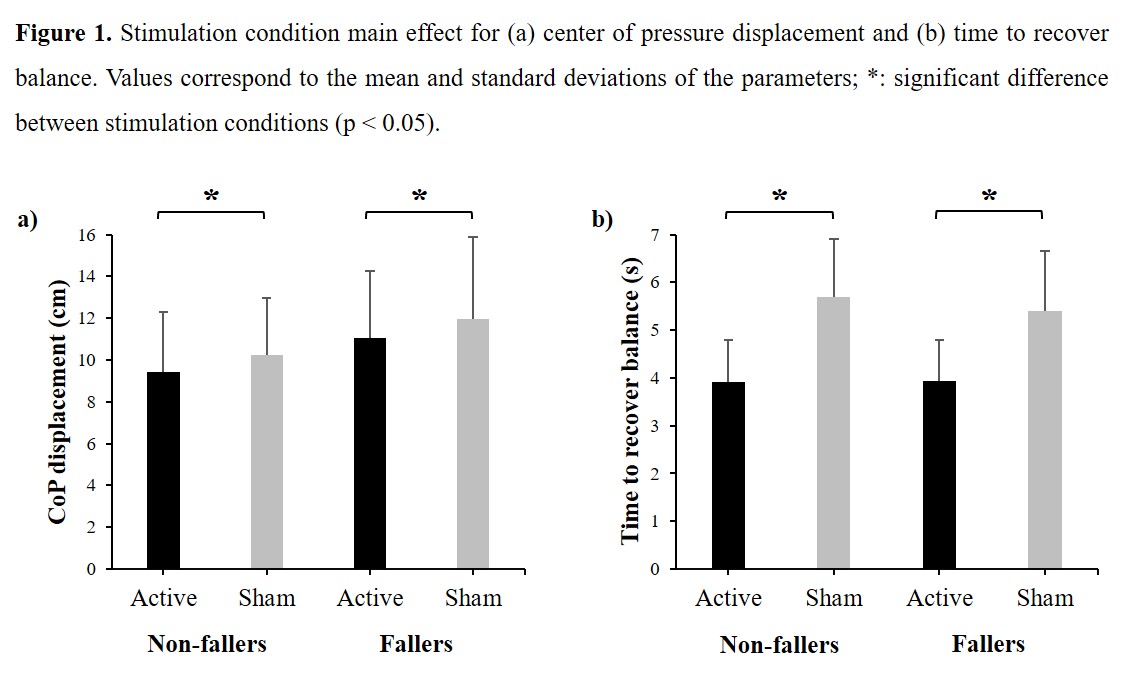Objective: To analyze the effects of a single session of transcranial direct current stimulation (tDCS) on postural responses to external perturbations in people with Parkinson’s disease (PwPD) fallers and non-fallers.
Background: Postural control impairments are among the primary causes of falls in PwPD [1]. Specifically, PwPD fallers have greater deficits in postural responses to external perturbations compared to non-fallers [2]. Although anodal tDCS over the primary motor cortex (M1) has been shown to improve postural responses in PwPD [3], it remains unclear if both fallers and non-fallers may benefit from tDCS.
Method: Twenty-two PwPD (10 non-fallers and 12 fallers) participated in this study. Participants were considered fallers if they had at least one fall in the previous 12 months. Anodal tDCS was applied over the M1 with active (2 mA) and sham (placebo) stimulation conditions on 2 different days (~2 weeks apart) for 20 min immediately before the postural assessment. The presentation order of conditions was randomized across subjects. The postural response was assessed by 7 trials with backward support-surface translations with standardized velocity and displacement (20 cm/s and 5 cm) for all participants. The range and velocity of the center of pressure (CoP) were analyzed in 2 reactive periods (early and late responses). CoP displacement was analyzed only in the late response period and time to peak and time to recover balance were analyzed regardless of the periods. Two-way ANOVAs with factors for group (non-fallers x fallers) and condition (active x sham) were applied.
Results: ANOVA revealed no significant group x condition interactions. Both groups demonstrated shorter CoP displacement (F1,20 = 5.40; p = 0.031; ƞp2 = 0.213) and shorter time to recover balance (F1,20 = 37.07; p < 0.001; ƞp2 = 0.650) after active tDCS condition compared to sham [figure 1]. Standardized response mean was moderade for CoP displacement (fallers = -0.5 and non-fallers = -0.55) and large for time to recover balance (fallers = -1 and non-fallers = -1.9).
Conclusion: A single session of active anodal tDCS over M1 improves postural responses in both PwPD fallers and non-fallers.
References: 1. Ashburn A, Stack E, Ballinger C, Fazakarley L, Fitton C. The circumstances of falls among people with Parkinson’s disease and the use of Falls Diaries to facilitate reporting. Disabil Rehabil. 2008;30(16):1205–1212. DOI: 10.1080/09638280701828930. 2. Moraca GAG, Beretta VS, Dos Santos PCR, Nóbrega-Sousa P, Orcioli-Silva D, Vitório R, Gobbi LTB. Center of pressure responses to unpredictable external perturbations indicate low accuracy in predicting fall risk in people with Parkinson’s disease. Eur J Neurosci. 2021;00:1–11. DOI: 10.1111/ejn.15143. 3. Beretta VS, Vitório R, Nóbrega-Sousa P, Conceição NR, Pereira MP, Gobbi LTB. Effect of Different Intensities of Transcranial Direct Current Stimulation on Postural Response to External Perturbation in Patients With Parkinson’s Disease. Neurorehabil Neural Repair. 2020;34(11):1009–1019. DOI: 10.1177/1545968320962513.
To cite this abstract in AMA style:
G. Moraca, V. Beretta, D. Orcioli-Silva, M. Pereira, B. Legutke, R. Vitório, L. Gobbi. A single session of transcranial direct current stimulation improves the postural responses after external perturbations in both people with Parkinson’s disease fallers and non-fallers [abstract]. Mov Disord. 2021; 36 (suppl 1). https://www.mdsabstracts.org/abstract/a-single-session-of-transcranial-direct-current-stimulation-improves-the-postural-responses-after-external-perturbations-in-both-people-with-parkinsons-disease-fallers-and-non-fallers/. Accessed December 30, 2025.« Back to MDS Virtual Congress 2021
MDS Abstracts - https://www.mdsabstracts.org/abstract/a-single-session-of-transcranial-direct-current-stimulation-improves-the-postural-responses-after-external-perturbations-in-both-people-with-parkinsons-disease-fallers-and-non-fallers/

